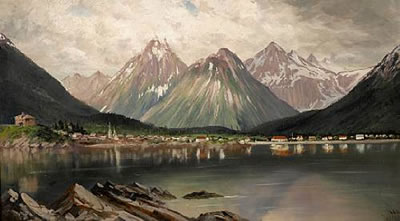|
Active in the late nineteenth and early twentieth century, James Everett Stuart was a landscape painter, who concentrated his attention on the mountainous regions of the Pacific Northwest, California, and Alaska. James Everett Stuart was a prolific painter of the west coast, said to have produced over 5,000 paintings of west coast scenery over his lifetime. Stuart was the grandson of famous portraitist Gilbert Stuart.
Born near Bangor, Maine, Stuart traveled with his family via the Isthmus of Panama, landing in San Francisco in December of 1860. Within a few days, the family moved to a sheep and cattle ranch at the lower end of Grand Island, on the Sacramento River, near Sacramento, while Stuart and his older brother attended school downriver in Rio Vista. Stuart’s first painting efforts coincided with his arrival in California, when he created sketches while boating along the Sacramento and San Joaquin rivers, using “paints secured from empty cans from which fishermen had painted their boats” along with brushes made from the tails of cats.
Stuart was a prize student under Virgil Williams and R.D. Yelland at the California School of Design in the late 1870s. Stuart later migrated to Portland, Oregon and became a leading member of the art scene there for several years. His name appears first in a list of the founding members of the Portland Art Club, preceding those of such fine painters as Cleveland Rockwell and Grafton Tyler Brown.
In 1879, Stuart returned to the Pacific Northwest, visiting the Columbia River and The Dalles, where a recent fire’s destructive impact led Stuart to believe he could find work painting new signs. He found the area rich in artistic subjects, which he discovered and rendered on camping and painting trips, among them to Celilo, where a Native American tribe had a headquarters. He established a studio in the southern Oregon town of Ashland in 1880, and after another visit to The Dalles in 1881, he opened “his first public studio in Portland, Oregon.” Although he had to struggle to maintain his studio and continue his sketching tours into the mountains, he was able to sell his work to wealthy Portland businessmen.
In June of 1891, Stuart sailed for Alaska, where he established a summer headquarters in the city of Sitka, and painted nearby locales, including the Muir Glacier. Obtaining passage on a trading schooner, he traveled to Yakutat, and along the way obtained views of Mts. St. Elias and Fairweather.
James Stuart made subsequent trips to Alaska in 1893, 1897, and 1903. After a stay in California in 1891 and 1892, Stuart spent the summer in Minneapolis, where he made sales of his paintings, before moving in October of 1892, to Chicago, where he established a studio and gallery. He remained in Chicago for twenty years before settling in San Francisco in 1912, at first renting a floor in the Rothchild Building at 239 Geary Street and then moving in 1923 to 684 Commercial Street. In the period that followed, he was highly successful. James Stuart sold works both from his studio and from a gallery that he operated until his death in 1941.
Paintings by Stuart are in the collections of the de Young Museum in San Francisco, the California State Library in Sacramento, University of Southern California, Los Angeles County Museum and the White House. Many prominent individuals purchased Stuart’s works including the banker J. P. Morgan, the art collector Thomas B. Clark, the minister Henry Ward Beecher, the merchant Marshall Field, and John D. Rockefeller of Standard Oil. Stuart felt that one of his greatest achievements was to develop a means of painting on aluminum, a non-corrosive metal that would outlast canvas.
Johnny Aculiak| Edwin Tappan Adney|
George Twok Aden Ahgupuk| Alvin Eli Amason| Saradell Ard| Belmore Browne| Vincent Colyer| Jules Bernard Dahlager| Lockwood De Forest| Frederick Samuel Dellenbaugh| William Franklin Draper| | Henry Wood Elliott| John Fehringer| Claire Fejes| Louis Agassiz Fuertes| Magnus Colcord Heurlin| Norman Jackson| Rockwell Kent| Sydney Mortimer Laurence| Fred Machetanz| Marvin Mangus| Milo Minock| James Kivetoruk Moses| Rie Munoz| Joseph Henry Sharp| James Everett Stuart| John Webber| Kesler Woodward|
|




